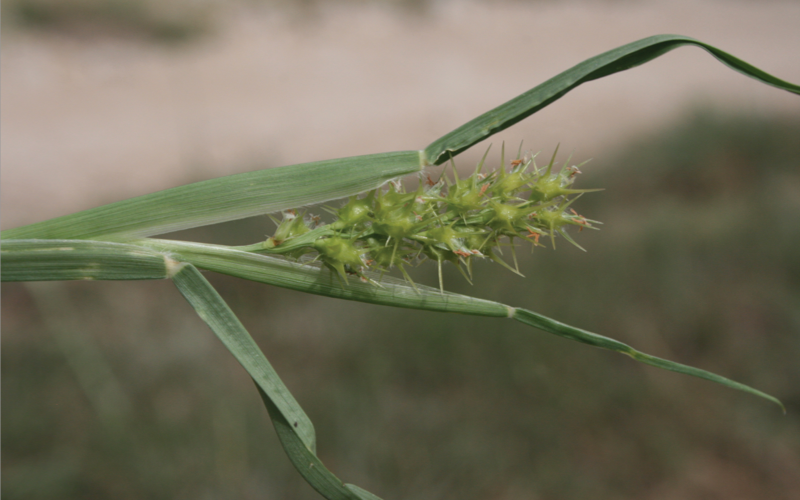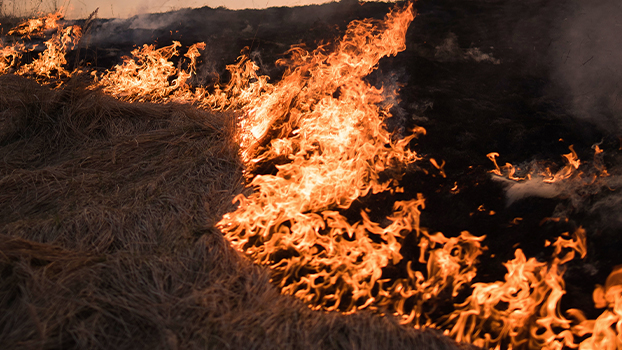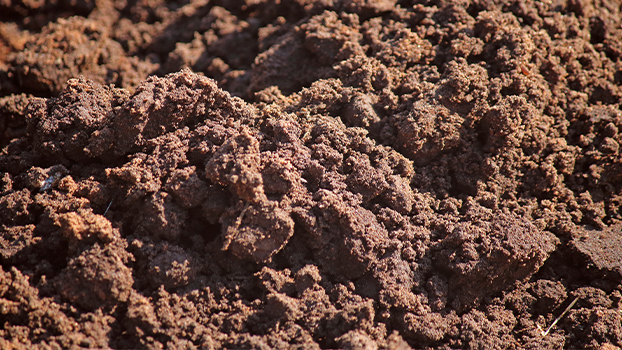What Is Sandbur?

Sandbur is a weed that diminishes the quality of hay. It can be identified by the inflorescence that forms spiny burs when mature. These burs decrease bermudagrass quality on grazed and hay production sites.
There are several species of sandbur (Cenchrus spp.) across the United States, and while it’s generally thought of as an annual species, some species are classified as perennial or short-lived perennial. These perennial varieties are becoming more prevalent and are more complicated to control as preemergent herbicides don’t impact them and they’re still difficult to control with postemergent herbicides.
Sandbur solution programs
A diligent sandbur control program consists of:
//
Adequate soil fertility
// A timely late-winter preemergent application of Rezilon herbicide
// Frequent field scouting for perennial plants and/or escapes
// Postemergence application of Pastora® herbicide + Roundup® (4 lb. formulation) to control established or perennial plants
// A sequential Rezilon application midseason, generally after the first cutting, to prevent late-season germination of sandbur.

Preemergent solution:
Rezilon herbicide is the foundation of a good sandbur control program and may be used in bermudagrass, bahiagrass, or other warm season perennial pastures and hayfields. There are no grazing or haying restrictions when applied at 3 fluid ounces per acre in a single application.
Rezilon should be applied and incorporated with rainfall or irrigation well before sandbur or other annual grasses begin to germinate.
Since sandbur may germinate throughout the growing season, Rezilon (3 fluid ounces per acre) should be applied twice during the growing season: in late January to mid-February and again in mid-June to early July immediately after a hay harvest.
Applications should be made with flat fan or similar nozzles that allow for good, uniform spray distribution. Use a water carrier volume of at least 15 gallons per acre. Boomless nozzles and large FloodJet tips on wide spacings (e.g., 60 inches) are not recommended as they do not provide uniform spray distribution or soil coverage across the spray pattern.

Field scouting program:
Scouting for emerging, established or perennial plants is key to a successful sandbur program. In late winter and early spring, scout fields for sandbur plants persisting over winter. This can be determined by digging up plants and inspecting the crowns for green, living stems or vegetation.
If present, be prepared to make a postemergent herbicide application once sufficient vegetation exists to take up the spray, preferably while plants are still small. Postemergence control will be reduced as plants get larger.
In late spring and throughout summer, scout fields for sandbur plants that may have escaped preemergent herbicide applications and perennial plants that survived the winter (look for dead stems from the previous year’s crowns mixed with green, actively growing stems). When possible, time a hay harvest prior to sandbur seed head emergence to avoid further seed production.
To limit crop response and maximize herbicide spray contact with sandbur, once hay is removed from the field, apply a postemergent herbicide spray of Pastora + Roundup.
It’s also critical to understand the growth cycles of other secondary weed species and incorporate them into your field scouting program. For example, horseweed (also known as marestail), common broomweed and musk thistle are typically known as summer annual weeds. However, these plants usually germinate in the fall.

Postemergent solution
Control of emerged or perennial sandbur plants requires a postemergent herbicide like Pastora, an herbicide that controls sandbur as well as 25 other problem grasses in bermudagrass pastures including little barley, rescuegrass, Johnsongrass, crabgrass and ryegrass (non-ALS resistant), plus over 100 broadleaf weeds like henbit, chickweed, mustards and many more.
Pastora use rates are 1-1.5 ounces per acre with a maximum of 2.5 ounces per acre per season. There are no haying or grazing restrictions.
Pastora can be applied in early spring before desired forage reaches 2 inches. If existing vegetation inhibits the spray from directly contacting sandbur leaves, unacceptable control will result. Under these conditions, apply soon after the next hay harvest.
Use flat fan nozzles on 20-inch spacing for the best coverage of sandburs. Small flood tips (TK 2.5’s-7.5’s) on 20-to-40-inch spacing can provide adequate coverage if water/fertilizer volumes are increased to a minimum of 20 gallons of solution per acre.
Pastora can be applied in water and/or liquid fertilizer carriers. When using a water carrier, adding 5%-10% liquid urea ammonium nitrate fertilizer enhances postemergence herbicide activity. If liquid fertilizer is used as the carrier, apply no more than 30 units of nitrogen per acre. Always refer to the label for addition of adjuvants.
It can also be used as a spot treatment by mixing 2.5 ounces in 100 gallons of water with an approved adjuvant.
Download Sandbur Solutions Brochure
Things to Consider When Combatting Sandbur
Knowledge of the pest, control practices, field scouting and much diligence is necessary to battle sandbur. A successful program uses integrated pest management (IPM) and combines cultural, biological and chemical measures. Once sandbur is established, it takes several years to reclaim the pastures.
Here are three key factors to help successfully manage sandbur:







